 In true online video blog style, the announcement was made by Mr Diddy (not one of Ken Dodd’s little friends), but differing from the norm, he’s filmed walking in to a Burger King and happens to drop their catch phrase a couple of times while order his burger to “have it his way”.
In true online video blog style, the announcement was made by Mr Diddy (not one of Ken Dodd’s little friends), but differing from the norm, he’s filmed walking in to a Burger King and happens to drop their catch phrase a couple of times while order his burger to “have it his way”.
Interestingly Mr Diddy says that he’s going to “Buy a channel on YouTube,” so we’re assuming that there’s money involved, especially as Mr Diddy refers to “The Contract” in his video piece.
Also of note, is that Mr Diddy has his own URL on YouTube – YouTube.com/diddyTV – certainly the first that we’ve seen that uses such a short form.
There’s also a great spoof of Mr Diddy’s video by Lisa Nova.
 Details of the deal between Mr Diddy and Burger King haven’t been disclosed, but we’d imagine that it’s going to be worth more that a couple of orders at their stores, even if his entourage are ordering large.
Details of the deal between Mr Diddy and Burger King haven’t been disclosed, but we’d imagine that it’s going to be worth more that a couple of orders at their stores, even if his entourage are ordering large.
Of course, this big step up by Mr Diddy has absolutely nothing to do with the new album that he’s releasing this month and is cunningly blip-cut into his video pieces.
 We attribute much of Mr Diddy’s knowledge and acceptance of YouTube down to Ryan Leslie, who is part of Mr Diddy’s posse (which we believe is the common parlance). Ryan has been using MySpace and YouTube for a long time to promote himself, his label Next Selection (for life) and his artists like Cassie. We’ve spoken about his work in many consultancy sessions that we’ve done with media companies – and frankly have great regard for the way he’s used the medium, such as his idea to get people to post their own lip-sync video on YouTube.
We attribute much of Mr Diddy’s knowledge and acceptance of YouTube down to Ryan Leslie, who is part of Mr Diddy’s posse (which we believe is the common parlance). Ryan has been using MySpace and YouTube for a long time to promote himself, his label Next Selection (for life) and his artists like Cassie. We’ve spoken about his work in many consultancy sessions that we’ve done with media companies – and frankly have great regard for the way he’s used the medium, such as his idea to get people to post their own lip-sync video on YouTube.
The absolute proof of this is Mr Diddy’s message to Ryan saying that he’d “finally talked him into it,” asking him to send over some of his friends to Mr Diddy’s Myspace. To show how these things roll, you’ll note that Mr Diddy doesn’t have Ryan in his Top 16 friends on his MySpace. You may also note that Mr Diddy has had over 10m plays of his tracks – some 4m of which for Come To Me, that was produced by Ryan Leslie. Where’s the friendship?
Google interested in buying YouTube?
Over the weekend there has been much chatter about YouTube being bought by Google, after it was rumoured by the WSJ. The figure banded around was $1.6Bn.
This would be the most expensive purchase that Google has made. Up until now they’ve been very smart and picked up other compaies at early stages for relative small change. The rumored figure for Blogger was $30m.
Google Video hasn’t been the boon that they had hoped it was going to be. Buying YouTube will take Google into the forefront of serving video online and with the $10Bn they’ve got in the bank, not an unfeasible amount for them to pay for it. When put into historical context, it appears a pretty cheap price – don’t forget that Yahoo paid $7.5Bn for broadcast.com back in the Web 1.0 days.
 It’s been a long, long wait, but it looks like the release of Microsoft’s new operating system, Windows Vista, is finally set to happen soon.
It’s been a long, long wait, but it looks like the release of Microsoft’s new operating system, Windows Vista, is finally set to happen soon.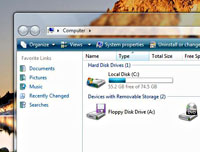 Vista has a scheduled roll out date for business customers next month, with consumers getting to play with the new desktop in January 2007.
Vista has a scheduled roll out date for business customers next month, with consumers getting to play with the new desktop in January 2007. Sherlund also noted that he expects Microsoft to start dishing out Vista discount coupons to customers who buy new PCs capable of running the OS in the run-up to the release.
Sherlund also noted that he expects Microsoft to start dishing out Vista discount coupons to customers who buy new PCs capable of running the OS in the run-up to the release. Looking like lovechild of a bedtime romp between an iPod and a mobile phone, Samsung’s X838 phone has real “gimme!” appeal.
Looking like lovechild of a bedtime romp between an iPod and a mobile phone, Samsung’s X838 phone has real “gimme!” appeal. Because of the narrow, slimline construction, the number keys are unusually arranged in rows of two, with the usual ‘call’ and ‘end call’ buttons at the top.
Because of the narrow, slimline construction, the number keys are unusually arranged in rows of two, with the usual ‘call’ and ‘end call’ buttons at the top. There’s also an easily accessible ‘hold’ button so you don’t end up ringing your Mum when you’re rocking out to Pantera, as well as a volume up/down control on the side of the unit.
There’s also an easily accessible ‘hold’ button so you don’t end up ringing your Mum when you’re rocking out to Pantera, as well as a volume up/down control on the side of the unit. We spent some time trying to translate the text from the
We spent some time trying to translate the text from the 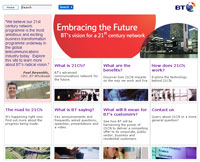 BT has released detailed plans for the rollout of its next generation 21CN network.
BT has released detailed plans for the rollout of its next generation 21CN network.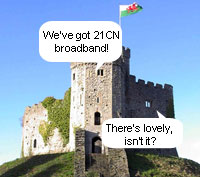 “Planning the rollout programme has been a complex task with industry consulted at every stage. Work is now well underway to create the new backbone for 21CN – this has to be in place across large parts of the UK before the first customer lines are switched across,” she added.
“Planning the rollout programme has been a complex task with industry consulted at every stage. Work is now well underway to create the new backbone for 21CN – this has to be in place across large parts of the UK before the first customer lines are switched across,” she added. Nokia has unveiled their latest move to bring themselves ever closer to being associated with video content and its creation.
Nokia has unveiled their latest move to bring themselves ever closer to being associated with video content and its creation. Another major advantage for PodShow is the delivery of their content to consumers. PodShow majors on audio content, which is not too difficult to deliver over the average broadband connection. The story changes when many people are watching on-demand video content. Getting this type of content delivered smoothly across the network has always been a headache. This only multiplies when the majority of the content moves from predominately audio to video.
Another major advantage for PodShow is the delivery of their content to consumers. PodShow majors on audio content, which is not too difficult to deliver over the average broadband connection. The story changes when many people are watching on-demand video content. Getting this type of content delivered smoothly across the network has always been a headache. This only multiplies when the majority of the content moves from predominately audio to video. Will it succeed?
Will it succeed? Vonage have launched a new means of making VoIP calls on you PC – a USB stick with headphone socket.
Vonage have launched a new means of making VoIP calls on you PC – a USB stick with headphone socket.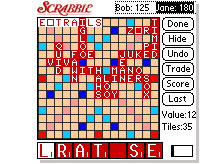 Currently sending our productivity levels downwards at a worrying rate is the hideously addictive Scrabble for the Palm OS by Handmark.
Currently sending our productivity levels downwards at a worrying rate is the hideously addictive Scrabble for the Palm OS by Handmark.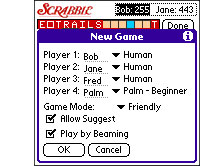 The game offers four levels of automated computer opponent: Beginner, Novice, Intermediate, or Expert.
The game offers four levels of automated computer opponent: Beginner, Novice, Intermediate, or Expert. Even in expert mode, the computer was able to come up with challenge-destroying words almost instantaneously, so the only thing slowing the game down was our own ineptitude.
Even in expert mode, the computer was able to come up with challenge-destroying words almost instantaneously, so the only thing slowing the game down was our own ineptitude. A few week back, BT confirmed that they have closely tied themselves with US podcast aggregator, PodShow, so closely in fact, that they’ve stuck BT at the front of PodShow domain to form BTPodShow.
A few week back, BT confirmed that they have closely tied themselves with US podcast aggregator, PodShow, so closely in fact, that they’ve stuck BT at the front of PodShow domain to form BTPodShow. Where does the income come from?
Where does the income come from?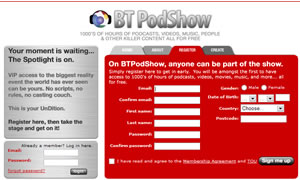 We wondered if the higher resolution video might not be put out on the Website, but reserved for BTVision, to which Patterson said, “The experience that people have over the Internet will not be sufficient for the TV space. I anticipate it will happen.”
We wondered if the higher resolution video might not be put out on the Website, but reserved for BTVision, to which Patterson said, “The experience that people have over the Internet will not be sufficient for the TV space. I anticipate it will happen.” Ofcom has announced that Ed Richards is taking over the uber-communications agency CEO reigns, effective today.
Ofcom has announced that Ed Richards is taking over the uber-communications agency CEO reigns, effective today. * Ensuring that Ofcom’s voice is heard on key issues. Ofcom to its credit, tend to think and act in an evidence-based manner, but are surrounded by a regulatory environment which is highly politicised. This has been particularly true in both the media and new media, an area where Stephen Carter’s Ofcom often produced good thinking, but was unable to translate that into actual policy (eg, BBC charter review). Richards comes from the political world, and this might benefit Ofcom in that respect.
* Ensuring that Ofcom’s voice is heard on key issues. Ofcom to its credit, tend to think and act in an evidence-based manner, but are surrounded by a regulatory environment which is highly politicised. This has been particularly true in both the media and new media, an area where Stephen Carter’s Ofcom often produced good thinking, but was unable to translate that into actual policy (eg, BBC charter review). Richards comes from the political world, and this might benefit Ofcom in that respect.